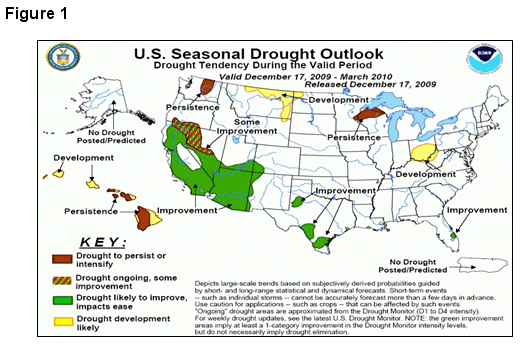Vol. 26, Issue 1, January 5, 2010 – PDF version
Jose G. Peña, Texas AgriLife Extension Economist-Management
Substantially increased rainfall during the last four months of 2009, has improved the agricultural situation in Texas after a severe drought and economically difficult year. Early estimates indicate that about $3.5 billion in farm gate income was lost in Texas during 2009, directly as a result of the drought. In addition, USDA’s Nov. 2009 estimate of U.S. net farm income for 2009 at $57.0 billion, is down 34.5 percent from 2008’s record high. The reduction is primarily attributed to the recession, reduced demand and lower commodity prices, especially for livestock agriculture which forms a large proportion of agricultural income in Texas. The economic situation appears brighter this year, as the recession appears technically over and a slow recovery is underway.
As measured in Uvalde, Texas, cumulative rainfall in 2009 ended at about 70 percent of the long term average. Rainfall during the last four months, however, accounted for about 70 percent of the annual total. Rainfall during the fall period was kick started by over twice the long term rate in September. The year ended at 140 percent of the long term average for those last four months, after a severe drought during the first eight months.
The agricultural and the moisture situations appear to have improved much more than the annual rainfall statistics would imply. Cool weather this past fall and winter has really helped to conserve moisture. While freezing temperatures in early Dec. ’09 and early Jan. ’10 caused damage to some horticultural crops, the amount of rainfall during the last four months and the timing of that rainfall was such that the sum of rainfall exceeded the sum of evapotranspiration on every day during fall growing period, starting around Sept. 8, 2009, i.e., the amount of rainfall exceeded the amount required to sustain maximum plant growth. Stated differently, moisture requirements did not exceed the moisture provided by the increased and very timely delivered rainfall during the fall growing period. The increased and very timely rainfall, together with the cool weather, which has helped conserve moisture, has improved the agricultural situation for most of Texas, but especially the Southwest, Texas region.
Drought Outlook
In addition to this past fall’s excellent growing conditions, the National Weather Service is forecasting excellent rainfall conditions, at least through the end of March 2010 (see Figure 1).
Appreciation is expressed to Dr. Hagen Lippke, Assoc. Prof. Ruminant Nutrition for his contribution to review of this article.

